Services on Demand
Article
Indicators
Related links
-
 Cited by Google
Cited by Google -
 Similars in Google
Similars in Google
Share
Journal of the Southern African Institute of Mining and Metallurgy
On-line version ISSN 2411-9717
Print version ISSN 2225-6253
J. S. Afr. Inst. Min. Metall. vol.115 n.7 Johannesburg Jul. 2015
http://dx.doi.org/10.17159/2411-9717/2015/V115N7A12
GENERAL PAPERS AND TECHNICAL NOTE
Visions for challenging assets in the South African coal sector
Z. van Zyl
Mining Consultancy Service (Pty) Ltd
SYNOPSIS
The southern African coal industry is facing the reality that coal reserves are becoming deeper and harder to mine than before. Alternative visions need to be considered to offset the impact of these challenges on productivity, cost, and profitability. One of the main challenges is to maintain current production levels under more difficult conditions, and improve productivity where conditions allow. There is a need to move from the reactive event-based management system towards the more adaptable and flexible process-based management system. This paper focuses on underground coal mining, but the principles are also applicable to other commodities and mining methods. This paper is based on research undertaken by the personnel from Mining Consultancy Services Pty Ltd (MCS) on trends in the underground coal mining sector, as well as practical experience over a period of 16 years in the field of electronic monitoring of mining machinery and productivity optimization.
Keywords: productivity, optimization, Prodmate, reporting, handheld device, monitoring, improvement, utilization, key performance indicators, coal mining
More challenging conditions facing the coal mining industry
There are a number of challenges facing the coal mining industry. These range from physical conditions through to socioeconomic challenges. This paper will deal mostly with physical challenges, although the approach discussed would apply equally to any challenge. An analysis of the changes in physical mining conditions over the past seven to eight years found that the following elements have had an impact on productivity:
➤ The introduction of the 12 m cutting rule in the first part of the previous decade. This rule limits the distance that a continuous miner can cut from the last row of roof support to 12 m, instead of longer distances (up to 24 m and more) that were used previously. The rule was introduced as a measure to prevent explosions by limiting dust levels, as well as preventing roof falls
➤ Reduction in seam thickness and mining height
➤ Shortening of panels and more frequent section moves, which have an adverse influence on production
➤ Greater frequency of geological problems: faults, dolerite intrusions, floor rolls etc. Each problem poses a challenge to both productivity and safety, and these are more frequent as the more easily accessed resources on aging mines have already been depleted
➤ Increased support density requirements to prevent roof falls. Most coal mines are now on systematic support rules and rib-side support is becoming more prevalent. This is as a result of the impact of aging mines' strategies (to mine more difficult areas, as described above) as well as restrictions imposed internally by companies and through the Department of Mineral Resources (DMR) to combat roof and rib-side related accidents.
Case study: seam thickness and mining height reduction
MCS has recently undertaken an analysis of the change in the practical mining height of approximately 28 continuous miner (CM) sections in the Witbank and Highveld coalfields over a period of eight years, from 2005 to 2012. The results are shown in Figure 1. As can be seen, the average practical mining height decreased from above 4 m to just under 2.9 m over the period analysed, and the trend seems to be continuing. This has partly come about due to the depletion of 2 Seam reserves with high seam heights, and the subsequent migration to 4 Seam areas with lower seam heights. The 2 Seam reserves were targeted first due to their higher yield. The other major reason is that, where given the choice, mines elected to mine the higher 4 Seam areas in preference to the lower areas, and as the higher seam areas become mined out the average seam height decreases. Thus more linear metres have to be mined for every ton of coal that is produced, putting pressure on productivity.

Case study: CM section output
For underground coal mining, 'millionaire' status is an aspirational target, which means that a section produced a million run-of-mine (ROM) tons in a year. From a benchmark database of more than 100 CM sections in South Africa we extracted the results to determine the number of 'millionaire' sections over the past few years. The results, shown in Figure 2, clearly illustrate that, during a period when management practices and technology continuously evolved with the aim of improving productivity levels, there had been a steady decline in the number of millionaire sections; largely due to the factors mentioned above.

Attributes of top performers
Mining conditions are important, but are not the only driver of productivity. Figure 3 illustrates this by comparing the output of 20 CM sections, with similar mining conditions and with the same equipment, over a period of one year. There is a wide differentiation between the top and bottom performers.

Through the involvement of MCS with productivity optimization projects at many of the underground coal mines in South Africa, a model, shown in Figure 4, was developed to explain this phenomenon.
Figure 4 illustrates that all sections are exposed to the same:
➤ Production events, such as the need to relocate from one roadway to the next after completing the 12 m cut
➤ Equipment events, such as breakdowns and advances in technology
➤ Geological events, such as encountering anomalies i.e. faults and dykes
➤ Market events, such as changes in prices and logistical constraints
➤ HR events, same staff complement
➤ Legislative events, regulating activities of all sections. Despite these events, which are common to all sections, there is a difference in output as illustrated in Figure 3. Why? The reasons are that the top performers:
➤ Know about the events, like all average performers would
➤ Understand the events, like most average performers would
➤ Understand the production process, like some average performers would
➤ Understand the impact of the events on the production process, likefew average performers would
➤ Make changes to improve the affected process. For average performers, this rational progression is unlikely.
The steps that connect the events to the change in process that would mitigate the event's adverse effect is what we refer to as the 'process-based management ladder', as shown in Figure 4. The second step in the ladder 'Provide adequate and reliable information' is often done in underground coal mines through the introduction of electronic machine monitoring systems on the CMs, which are the primary coal-winning equipment. The results from the monitoring systems are then compared to other sections with similar systems to benchmark the sections in question against industry best practice and determine the improvement potential. The results from the machine monitoring systems are expressed in such a way that they measure the fundamental mining processes from the CMs. These process-based metrics allow the underlying constituent processes of the mining method to be managed and improved. By improving the process that deviates the most from industry benchmarks, inherent value is unlocked and the productivity of the mining method is improved.
Process-based production management was first envisaged and introduced in the late 1980s as a means of redirecting the focus of production optimization to manageable practices that would produce sustainable improvements. This management system encourages the section personnel to build a strong foundation of the process steps, instead of focusing on the result.
Through MCS's experience in more than 30 successful productivity optimization projects on coal mines, the author has found time and again that the change from event-based management to process-based management is the key to unlocking latent potential. This can be done only when the mine has the ability to measure each of the production processes that occur in a section accurately and reliably. It is therefore no surprise that the application and growth in process-based management has gone hand-in-hand with improvements in the monitoring hardware and software, resulting in progressively more accurate and reliable data. The fact that almost all new continuous miners sold into the market now come equipped with advanced monitoring capability, bears testimony to this.
As the demands and pressures of reducing costs and maintaining performance have recently increased, new advances and approaches in technology to support process-based management are required, as described further in this paper.
Process-based production management
MCS has come to understand exactly what process-based production management is. In its simplest form it is the management of primary productivity drivers. The first step towards managing constraints effectively entails understanding what the constraints are. Radical advances in the use of progressive software and hardware to monitor and examine section data has led to many benefits, such as: > The ability to integrate machine-generated and manually captured data
➤ Creating a management system that can be used to manage all aspects of the production operation
➤ Effective time management while fostering simple and less confrontational accountability among employees
➤ Making information transparent so that communication and effective use of skills and experience is improved.
This is backed up by effective change management so the new methodologies are less prescriptive and more likely to become habit-forming, thereby sustaining the improvements.
Process-based management works. It is an effective means of advancing the value of the asset and output by sustaining the day-to-day improvements gained by revolutionizing the operating methods. The effectiveness of process-based management methodology is substantiated by the results achieved, as illustrated in Figures 5 and 6.
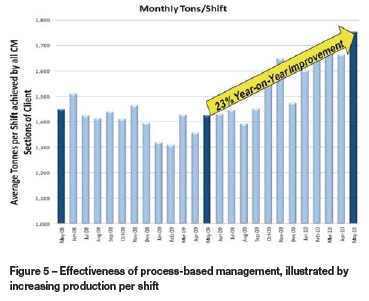
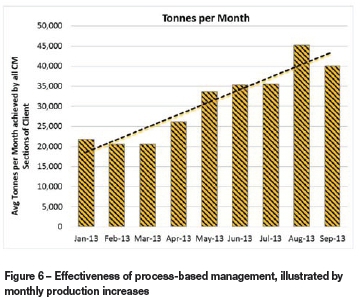
By empowering people with relevant information to manage the performance of their section, management encourages workers to embrace improvement through technology and change.
Experience over the past 26 years has indicated that there are three pillars to effective and sustainable process-based management and productivity optimization (Figure 7).
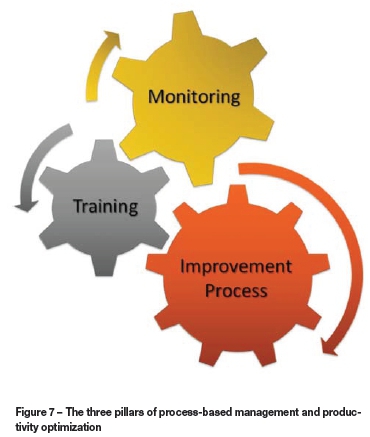
➤ Monitoring. Accurate and reliable processmeasurement, using data obtained from production machines. The monitoring is based only on the primary cutting machine, and focus on the following production rate (efficiency) KPIs:
• Loading time
• Away time
• Tram time per metre cut
These are primarily machine-related issues.
Time management would include the monitoring of the
first and last operation of the continuous miner
➤ Training. Training of relevant personnel to analyse, interpret, and understand the measurement system and what they can do towards improving each of the KPIs that are under their control
➤ Improvement process. A practical improvement process where KPIs are reviewed; action plans are generated, implemented, and tracked; and unquestionable accountability for the KPIs is held across the management structure on the mine.
This holistic approach to productivity optimization has consistently delivered the best results. It is based on the interconnectedness of all the aspects; leaving one out will erode the effectiveness and sustainability of the process.
Owing to the factors described at the beginning of this paper, it has become increasingly difficult to maintain productivity at constant and acceptable levels, before aspiring for improvements. Over the past seven to eight years, productivity improvements were much more likely to be achieved through improvements in production rates (efficiency) rather than improvements in production time (utilization). This is illustrated in Figures 8, 9, and 10, which show utilization (Figure 8) and efficiency (Figures 9 and 10) KPI trends over a sample of 25-30 bord and pillar CM sections.
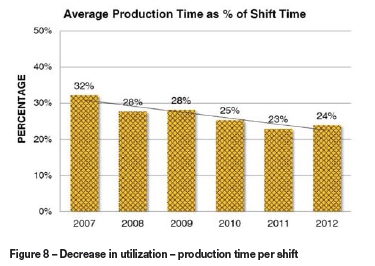
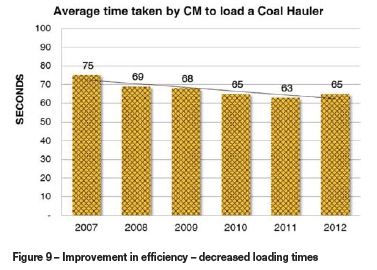
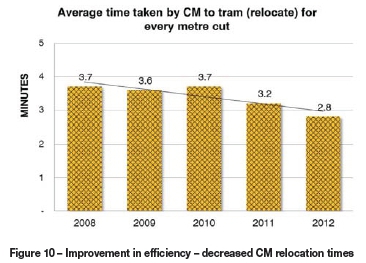
Figure 8 shows a decline in the average production time per shift, but the research personnel found that the productivity of the sections from which the data was taken did not decline, but rather remained constant. This is due to the improvement in efficiency of the sections as indicated in Figure 9, which shows the improvement in the time taken to fill a coal hauler, and Figure 10, which shows improvements in the efficiency with which the CMs are relocated from one cutting position to the next.
Traditional machine monitoring systems have largely been used to improve efficiency using loading and away time, which offsets the losses caused by decreased production time, as illustrated by the CM loading time trend in Figure 9 and tramming efficiency in Figure 10 for the same data sample. The declining trend in utilization (Figure 8) prompted the research team to investigate better ways of measuring machine utilization, as described in the next section.
Mining process measuring systems
Traditional machine monitoring systems have been effective at measuring and managing the efficiency of machines, but inadequate when it comes to measuring and managing utilization. This led to the development of a underground reporting system, ProdMate®, that allows for monitoring of key utilization performance indicators on production machines (CMs, roofbolters etc.), downtime (maintenance), planning (HR, inventory, supplies), and procedures. The reporting system combines manual and electronic data to produce a range of outputs, which can be utilized by generic enterprise reporting programmes (like SAP) to streamline production and improve utilization. Time-related issues include reporting of utilization of the machine as well as the downtime. Non-reported time has become an increased problem in recent years, and the introduction of handheld reporting devices has reduced this phenomenon significantly.
The system essentially comprises a suite of software applications that are run on an intrinsically safe handheld computer or personal digital assistant (PDA) as shown in Figure 11. Information is entered by the user (usually the section miner) and serves as a replacement for paper-based reports.
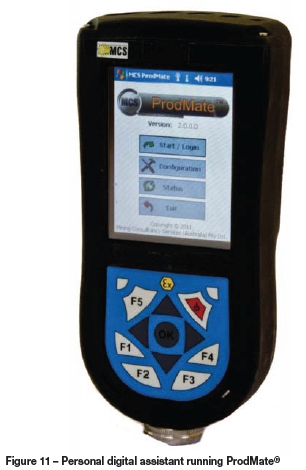
The inputs that relate to machines, materials, and other downtimes can then be integrated with the data from the electronic monitoring systems to provide an integrated reporting solution that encompasses close to 100% of the total shift time, as illustrated in Figure 12. Data can be extracted either via Wi-Fi interface or a cradle when docking the device to charge. Where a Wi-Fi data transfer system is used, the information is available in near real-time for use.
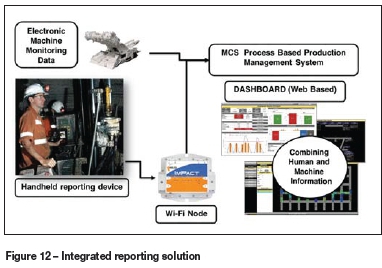
With the introduction of the unit to coal mines in Australia and South Africa, users have seen potential beyond the wide range of applications originally anticipated. This has led to the expansion of the system's capabilities (as demonstrated in Figure 13) to include the following:
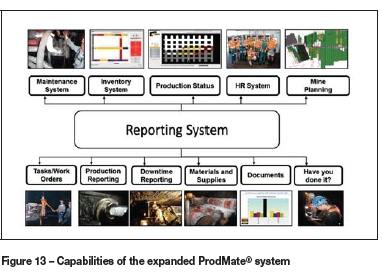
➤ Maintenance management system
➤ Inventory management system
➤ In-time production status updates
➤ HR control, time and attendance, and licence control
➤ Interactive mine planning and forecasting
➤ Task and work order creation and management
➤ Production reporting
➤ Downtime reporting
➤ Material and supplies management
➤ Document storage and retrieval
➤ Have you done it? (where any ad-hoc or periodic tasks can be loaded and managed).
Conclusions
This paper has indicated that the challenges that face the coal mining sector in South Africa are significant and serious. It shows that process-based management has served as an effective tool to improve and maintain productivity in the face of these challenges, but that many of the improvements have been in efficiency rather than utilization, i.e. production rate rather than production time. It indicates that as the challenges are likely to become more severe in the future, the application of process-based management will remain important. With the addition of improved measuring systems on utilization though applications such as the ProdMate® system, process-based management becomes even more effective.
Paper received Mar. 2015
Revised paper received June 2015














